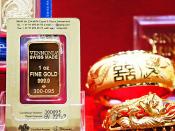Time Value of Money � PAGE \* MERGEFORMAT �1�
Running head: TIME VALUE OF MONEY
Time Value of Money
University of Phoenix
Finance 325
�
Time Value of Money
The time value of money is used to describe and asses the current value and future potential value of money. This paper will look at the effects of the future value of money by interest rates, compounding interest, opportunity costs, annuities and the Rule of 72.
How does the value of money increase over time? The only way to increase the value of money is to invest it and therefore increase the fund's future value. One of the most common ways of doing this is by investing these funds into an interest bearing account. This investment opportunity then raises the question "How much will this investment earn over time?" Using some simple calculations this question can easily be answered. A few items need to first be known in order to make this calculation.
How much you are investing which is called the present value (PV). The interest rate (i) this investment is going to earn. In addition, the number of periods (p) this money will be invested. Period can also be thought of as the interval at which the interest will be added to the account. Once these items are known the future value (FV) of the fund can be determined using the formula FV = PV * (1 + r)p .
The concept of earning interest on the interest itself is called compounding interest. This means that as the investment grows overtime the earned interest are themselves being reinvested and therefore also earning future interest. This is where the period comes into play. At the end of each period the interest is added to the fund balance.


